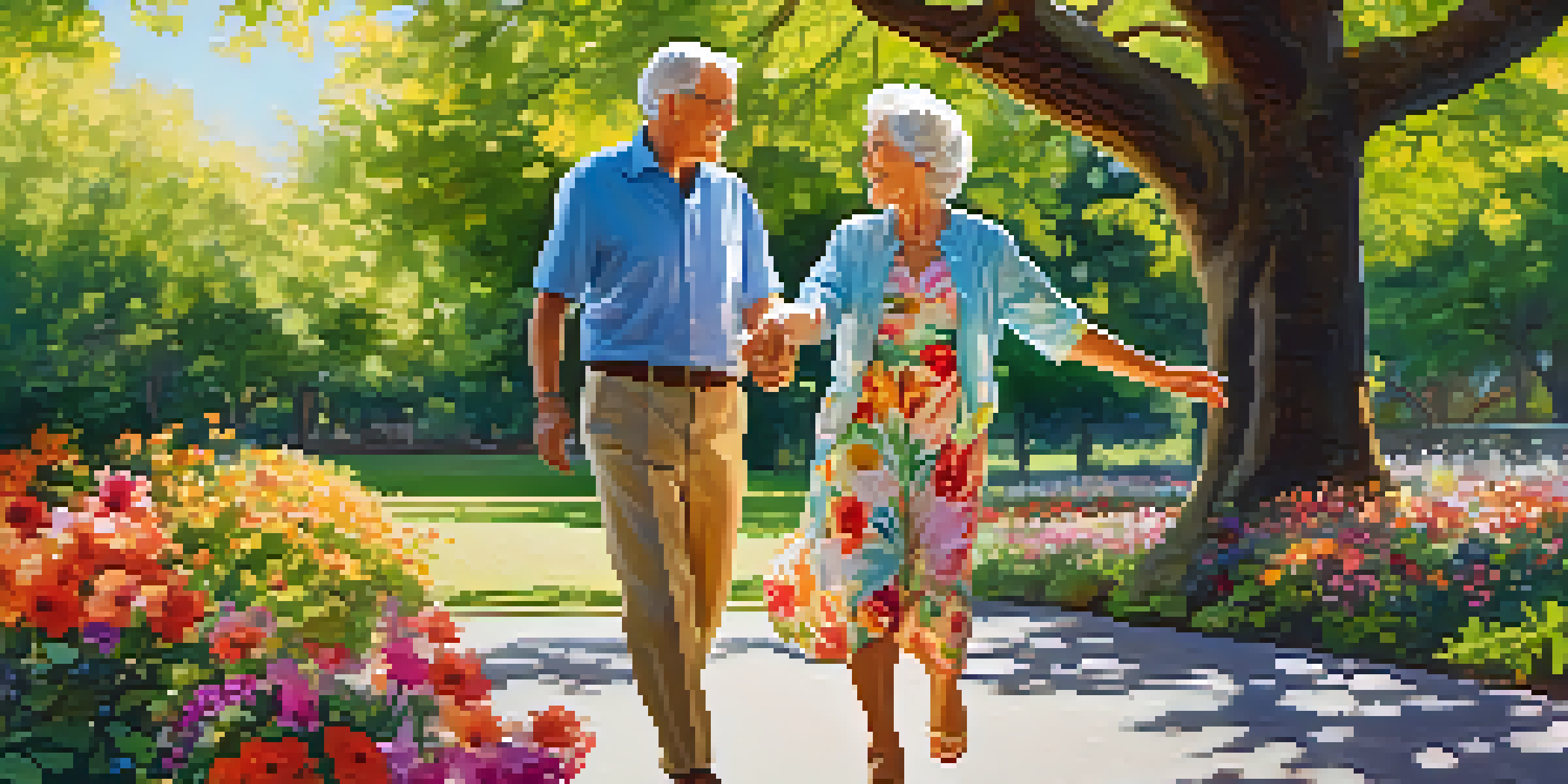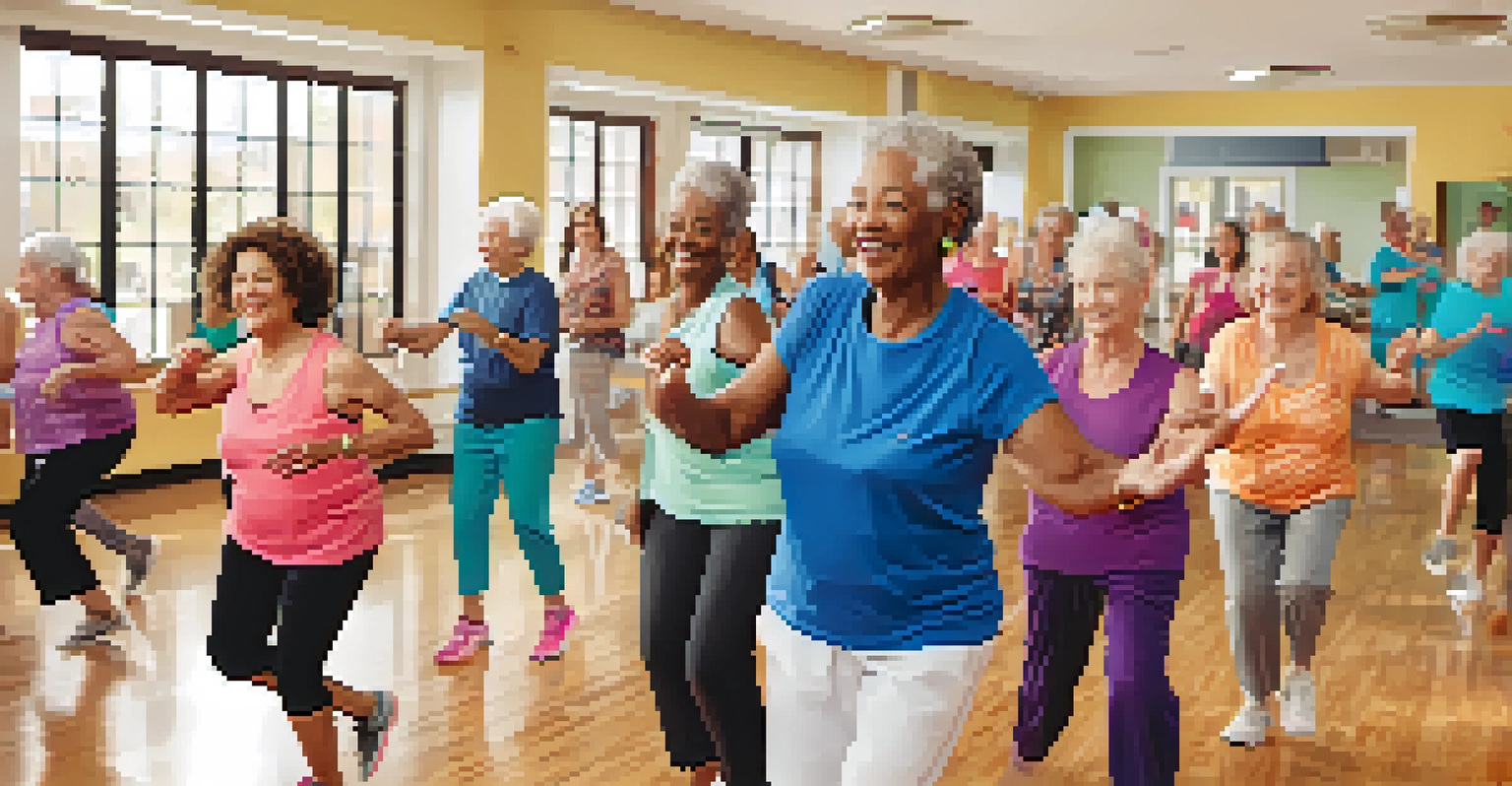Dance Styles for Older Adults: Finding the Right Fit

Why Dance is Beneficial for Older Adults
Dancing offers a wealth of benefits for older adults, from physical fitness to mental well-being. Engaging in dance can improve balance, coordination, and flexibility, making daily movements easier and reducing the risk of falls. Additionally, the social aspect of dancing can combat loneliness, fostering friendships and community connection.
Dance is the hidden language of the soul.
Beyond the physical perks, dance stimulates the mind. Learning new steps and routines can enhance cognitive function, keeping the brain active and engaged. This mental stimulation is particularly important as we age, helping to maintain memory and cognitive clarity.
Lastly, dance is a joyful activity that encourages self-expression. Whether it’s swaying to the music or participating in structured dance classes, older adults can find a sense of freedom and joy in movement, enhancing their overall quality of life.
Exploring Different Dance Styles
There are numerous dance styles to choose from, each catering to different preferences and abilities. From ballroom to line dancing, there’s something for everyone. Exploring various styles helps individuals find what resonates with them, making the experience enjoyable.

For those who enjoy a classic touch, ballroom dancing can be a wonderful option. It combines rhythm, grace, and social interaction, allowing dancers to connect with partners while moving across the floor. Plus, lessons often cater to all skill levels, making it accessible for beginners.
Dance Boosts Health for Seniors
Dancing enhances physical fitness, balance, and cognitive function while providing social connections that combat loneliness.
On the other hand, styles like Zumba Gold offer a more energetic approach, focusing on fun and fitness. This dance fitness program is designed specifically for older adults, featuring lower-intensity moves that are easy to follow, ensuring everyone can participate without feeling overwhelmed.
Finding the Right Class for Your Needs
When searching for a dance class, consider your physical abilities and comfort level. Many community centers and studios offer classes tailored specifically for older adults, ensuring a supportive and understanding environment. Don’t hesitate to ask about class sizes and instructor qualifications to find a good fit.
The dance is a poem of which each movement is a word.
It’s also beneficial to attend a trial class before committing. This allows you to gauge the pace and atmosphere of the class, ensuring it meets your expectations. Remember, the goal is to have fun while moving, so finding a class that feels right is essential.
Lastly, look for classes that prioritize safety. Instructors should be knowledgeable about modifications for various fitness levels, providing alternatives to accommodate everyone. A safe environment will let you focus on enjoying the dance without worry.
Adapting Dance to Your Physical Abilities
Dance is a versatile activity that can be adapted to accommodate physical limitations. Whether it’s using a chair for support or modifying certain moves, there are ways to ensure everyone can participate. Most instructors are trained to provide alternatives, so don't hesitate to communicate your needs.
If you have specific health concerns, consider consulting with a healthcare provider before starting a new dance program. They can offer personalized advice on which styles or modifications may be best suited for you. This proactive approach helps you dance safely and confidently.
Choose the Right Dance Style
With various dance styles available, individuals can find the one that suits their preferences and abilities, ensuring an enjoyable experience.
Additionally, remember that you can engage with dance in various ways. Even if you prefer seated dancing or gentle movements, you’re still benefiting from the rhythm and music. The key is to find a way to enjoy dancing that feels right for your body.
The Social Benefits of Group Dancing
Group dancing is not just about the moves; it’s also a fantastic way to meet new people. Participating in dance classes creates opportunities for social interaction, allowing you to build friendships with fellow dancers. These connections can greatly enhance your social life and provide a support network.
Moreover, dancing together fosters a sense of belonging and community. Engaging in shared activities can lead to lasting bonds, creating a warm and inviting environment that encourages participation and fun. This camaraderie can be particularly uplifting during challenging times.
Lastly, the shared experience of learning and improving can boost morale. Celebrating small victories, such as mastering a new step, becomes more enjoyable with others. Ultimately, group dancing not only enriches your physical health but also nurtures your emotional well-being.
Incorporating Dance Into Your Daily Routine
Incorporating dance into your daily life doesn't always mean attending formal classes. You can enjoy dance in the comfort of your home by playing your favorite tunes and moving to the rhythm. This informal approach can be a fun way to stay active without the pressure of structured lessons.
Consider setting aside time each week for a dance party at home. Invite friends or family to join in, or simply enjoy the music solo. This can be a delightful way to unwind, relieve stress, and keep your body moving throughout the week.
Make Dance Part of Daily Life
Incorporating dance into your routine can be as simple as enjoying music at home or participating in online classes, promoting ongoing physical activity.
Additionally, look for online dance classes or tutorials that fit your schedule. Many platforms now offer virtual classes catering to older adults, allowing you to dance at your own pace while still feeling part of a community. It’s a flexible option that empowers you to stay active on your own terms.
Tips for Staying Motivated in Dance
Staying motivated in your dance journey can sometimes be challenging, but setting small goals can help. Whether it's learning a new step or dancing for a certain amount of time each week, these milestones can keep you focused and excited. Celebrate your achievements, no matter how small, to maintain that enthusiasm.
Finding a dance buddy can also boost motivation. Having someone to share the experience with can make classes more enjoyable and encourage accountability. You can motivate each other and share tips, turning your dance sessions into a fun social outing.

Lastly, keep your dance routine fresh and exciting by exploring new styles or attending different classes. Variety will not only keep you engaged but also expose you to new movements and music, enriching your overall dance experience. Remember, the goal is to enjoy yourself, so let your passion for dance shine!